Water heating convectors: device, classification of types + installation tips
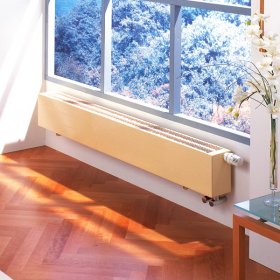
A comfortable microclimate in the house is a “merit” of many systems: heating, ventilation, and air conditioning. Habitual devices are gradually being replaced by more modern and high-tech ones. So, for example, what happened to the fans - at first their “mission” was taken over by the air conditioners, and soon more progressive and functional split- and multi-split-systems appeared. The same trend can be observed in the field of heating equipment: radiators are slowly giving way to the "palm" of convectors. In particular, water heating convectors are becoming an increasingly frequent confident choice for rational and practical homeowners.
Content
How are these devices arranged?
Water convectors are economical, reliable and durable devices that can transfer up to 95% of the heat flux into the room by convection. Successfully used both in autonomous and in central heating systems.
Water convectors consist of the following main structural elements:
- case (channel) made of stainless steel or galvanized steel, coated with powder paints;
- protective grill;
- heat exchanger - a copper pipe with fins from aluminum plates;
- connection nodes;
- vent valve.
Equipment can be connected to any type of supply pipes - regardless of their material and diameter.
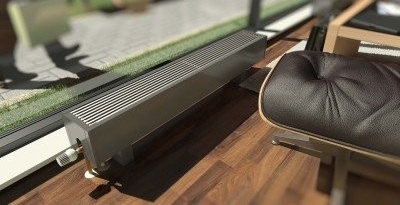
Water heating convectors - a rational choice for rooms with a large glazing area and a small window sill (or its complete absence)
Water heating convectors are successfully used for heating residential and industrial premises (including those with a large glazing area), offices, trade and exhibition halls, museums. In addition, the devices are perfectly suitable for installation in swimming pools, saunas, greenhouses, winter gardens - the only thing in this case, you should focus on the drainage version of the devices.
As for the principle of operation of the devices, the name "convector" already speaks for itself: hot air is distributed throughout the room by convection. Heat transfer occurs due to the heating of the air "in contact" with the heating element. Warm air, increasing in volume, enters the room through the outlet grilles of the device. And his place is cold. Such a “circuit” of heating is absolutely silent and comfortable.
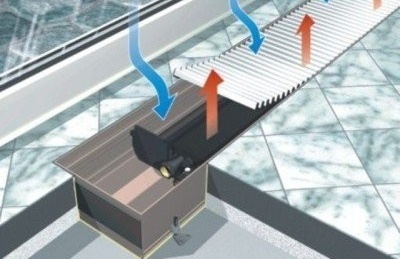
Water heating convectors quickly respond to temperature changes: they instantly heat up if it gets cold, and instantly stop heating if the room is too hot
Worth to know! Some models of water convectors can be equipped with a fan to increase heat transfer. The fan is also useful in that it prevents dust from settling on the device.
Classification of water convectors
Even 10-15 years ago it was impossible to solve the heating problem beautifully and elegantly. But they appeared - water convectors. Convectors that can look the way you like and are located not where “it works”, but there, “where it’s convenient”.
Depending on the design and installation method, these types of water units are distinguished:
- floor;
- baseboards;
- in-floor;
- wall mounted;
- basement.
Floor-mounted water convectors for heating allow heating a room of almost any size. The most uniform distribution of heat, and, consequently, more efficient heating will be facilitated by the placement of several devices connected in parallel in the room. Due to their low height, they can be installed in front of panoramic windows. Floor convectors are usually represented by models with one or two heat exchangers operating on the principle of natural convection.
If you want to buy reliable convectors in a modern design, be sure to pay attention to baseboards. Located around the entire perimeter of the room, such equipment provides high-quality heating of the air even at floor level and does not occupy usable area. The temperature of the body of baseboard convectors, as a rule, does not exceed 30 degrees, which means that it is absolutely safe to place furniture and other interior items in their immediate vicinity.
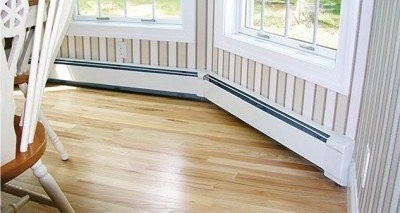
Plinth heating convectors provide high-quality and uniform air heating throughout the room: they are 100% cope with their task, even with high ceilings
Floor heating convectors are one of the most advanced solutions for arranging room heating. Such devices are a good choice for a private home and office. They are produced in two “variations”: with and without a fan, which determines the principle of their operation - forced or natural convection. Special models of floor convectors with condensate drain will help to qualitatively solve the issue of heating in rooms requiring a special microclimate.
Wall-mounted devices are the most popular and visually familiar. Differ in the maximum thermal power. Have one or two heat exchangers; at the request of the customer, manufacturing companies can increase their number to three. A wall convector is the best choice if you do not need design refinements and have the most ordinary windows.
Basement units (also called recessed ones) are modern equipment with wide possibilities for installation: it can be installed in wall niches, in stair steps, “integrated” into furniture or decorative partitions. The presence in the design of the progressive development of a tangential fan makes heating the room fast and high quality. Thanks to the built-in water convectors, it is possible to organize the heating system in the house as “veiledly" as possible.

Built-in water convectors are chosen by those who love custom solutions and appreciate every square meter of usable area in their home
Thanks to well-thought-out technical characteristics, all water convectors demonstrate such advantages:
- higher heating rate. In particular, in comparison with traditional radiators. And this is explained by the fact that the internal volume with a coolant in a convector is 80-90% less than that of a radiator.
- effective cutting off of cold air streams “seeping” from the windows. Creation of a powerful thermal curtain;
- low power consumption;
- low weight. This fact makes it possible to install the device on lightweight wall partitions made of drywall and other materials;
- compactness;
- fire safety.
In addition to the relatively high price, there is nothing more to say about the shortcomings.
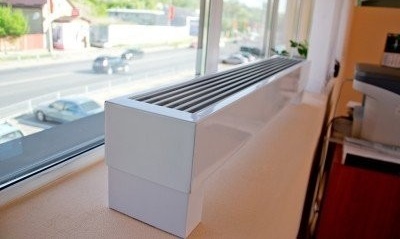
Compactness, low weight and attractive appearance of water heating convectors allow them to be successfully used in almost any interior, and high efficiency - in rooms for various purposes (residential, industrial, commercial)
Recommendations for installation and operation
Whatever type of water convectors you prefer, remember: the efficiency, safety and durability of devices largely depend on how skillfully and efficiently they are installed.
To cope with floor, wall and baseboard devices, in principle, is not difficult - it is enough to strictly follow the Installation Instructions and have experience in performing such work. But with the in-floor often have to pretty "tinker".
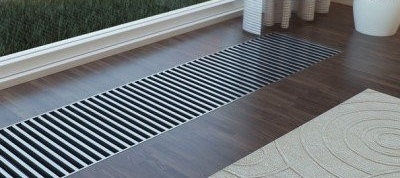
When installing an underfloor water convector, it is imperative to take into account the fact that the edges of the duct must be mounted on the same level with the finishing floor - not lower, and even less so
The basic rules and recommendations for installing underfloor water convectors are as follows:
- Devices should be installed in enclosed spaces.
- The equipment must be placed in such a way that the heat exchanger is located on the side of the device that is more distant from the window - if it is intended for the main heating of the room. In the event that the "mission" of the convector is solely to create an air curtain along the glazing, the heat exchanger should be "deployed" to the window.
- The recommended distance between the window and the convector is 25-30 centimeters.
- The dimensions of the mounting niche for the floor convector must exceed the dimensions of the device "in all directions" by 1-1.5 centimeters.
- The convector height adjustment should be carried out using the adjusting bolts located in the bottom of the product.
- For the supply and removal of coolant, it is necessary to use the flexible hoses and shut-off valves included in the delivery.
- Fixation of the device must be carried out using a mounting foam and cement mortar.
- Mechanical impact on the heat exchanger of the unit during installation is unacceptable: deformation of the plates can lead to disruption of the convection process.
Please note that poor-quality installation of equipment entails not only financial losses, but also poses a danger to life. Airing the convector provokes a decrease in the heat output of the equipment, up to the complete cessation of heat transfer.
Operation of devices without a protective grill is not recommended. Do not empty the heating system for more than two weeks a year. If ball valves are used as stop valves, their sharp closing or opening can provoke a water hammer - remember this.
Once every 1-2 months, it is necessary to clean the heat exchanger and the inner surface of the equipment case from natural household contaminants - dust, crumbs, other small debris. This procedure is quite easy - just remove the air outlet grill and vacuum / wipe with a damp cloth inside. The outer surface of the convector can be cleaned at least daily - the main thing is not to use aggressive chemical compounds.
After the three-year period of operation of the convector, it will not be superfluous to carry out a full check of it, it may be necessary to replace individual elements of the heating system.
Subject to these simple rules, water convectors will create maximum comfort and coziness in your home or workplace. This economical solution to the issue of heating is absolutely deservedly gaining more and more popularity.
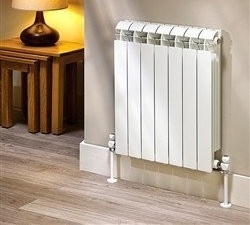
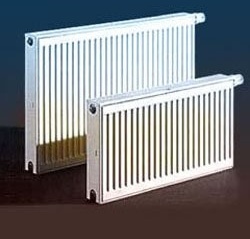
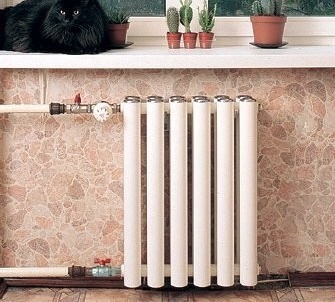
4 comments